1. Bray F, Ferlay J, Soerjomataram I, Siegel RL, Torre LA, Jemal A. Global cancer statistics 2018: GLOBOCAN estimates of incidence and mortality worldwide for 36 cancers in 185 countries. CA Cancer J Clin. 2018; 68:394–424. PMID:
30207593.

2. Van Cutsem E, Sagaert X, Topal B, Haustermans K, Prenen H. Gastric cancer. Lancet. 2016; 388:2654–2664. PMID:
27156933.

3. Chen WQ, Zheng RS, Zhang SW, Zeng HM, Zou XN, He J. Analysis of cancer incidence and mortality in elderly population in China, 2013. Zhonghua Zhong Liu Za Zhi. 2017; 39:60–66. PMID:
28104036.
4. Leo S, Accettura C, Gnoni A, Licchetta A, Giampaglia M, Mauro A, Saracino V, Carr BI. Systemic treatment of gastrointestinal cancer in elderly patients. J Gastrointest Cancer. 2013; 44:22–32. PMID:
23150086.

5. Saito H, Osaki T, Murakami D, Sakamoto T, Kanaji S, Tatebe S, Tsujitani S, Ikeguchi M. Effect of age on prognosis in patients with gastric cancer. ANZ J Surg. 2006; 76:458–461. PMID:
16768768.

6. Hall PS, Lord SR, Collinson M, Marshall H, Jones M, Lowe C, Howard H, Swinson D, Velikova G, Anthoney A, et al. A randomised phase II trial and feasibility study of palliative chemotherapy in frail or elderly patients with advanced gastroesophageal cancer (321GO). Br J Cancer. 2017; 116:472–478. PMID:
28095397.

7. Takama T, Okano K, Kondo A, Akamoto S, Fujiwara M, Usuki H, Suzuki Y. Predictors of postoperative complications in elderly and oldest old patients with gastric cancer. Gastric Cancer. 2015; 18:653–661. PMID:
24874161.

8. Takeuchi D, Koide N, Suzuki A, Ishizone S, Shimizu F, Tsuchiya T, Kumeda S, Miyagawa S. Postoperative complications in elderly patients with gastric cancer. J Surg Res. 2015; 198:317–326. PMID:
26033612.

9. Kim DH, Kim SM, Hyun JK, Choi MG, Noh JH, Sohn TS, Bae JM, Kim S. Changes in postoperative recurrence and prognostic risk factors for patients with gastric cancer who underwent curative gastric resection during different time periods. Ann Surg Oncol. 2013; 20:2317–2327. PMID:
23677605.

10. Sarfati D, Blakely T, Pearce N. Measuring cancer survival in populations: relative survival vs cancer-specific survival. Int J Epidemiol. 2010; 39:598–610. PMID:
20142331.

11. Edwards BK, Noone AM, Mariotto AB, Simard EP, Boscoe FP, Henley SJ, Jemal A, Cho H, Anderson RN, Kohler BA, et al. Annual report to the nation on the status of cancer, 1975-2010, featuring prevalence of comorbidity and impact on survival among persons with lung, colorectal, breast, or prostate cancer. Cancer. 2014; 120:1290–1314. PMID:
24343171.

12. Sarfati D, Koczwara B, Jackson C. The impact of comorbidity on cancer and its treatment. CA Cancer J Clin. 2016; 66:337–350. PMID:
26891458.

13. Lee L, Cheung WY, Atkinson E, Krzyzanowska MK. Impact of comorbidity on chemotherapy use and outcomes in solid tumors: a systematic review. J Clin Oncol. 2011; 29:106–117. PMID:
21098314.

14. Lacau St Guily J, Bouvard É, Raynard B, Goldwasser F, Maget B, Prevost A, Seguy D, Romano O, Narciso B, Couet C, et al. NutriCancer: a French observational multicentre cross-sectional study of malnutrition in elderly patients with cancer. J Geriatr Oncol. 2018; 9:74–80. PMID:
28888553.

15. Kim CY, Kim SY, Song JH, Kim YS, Jeong SJ, Lee JG, Paik HC, Park MS. Usefulness of the preoperative prognostic nutritional index score as a predictor of the outcomes of lung transplantation: a single-institution experience. Clin Nutr. 2019; 38:2423–2429. PMID:
30471794.

16. Fukuda Y, Yamamoto K, Hirao M, Nishikawa K, Maeda S, Haraguchi N, Miyake M, Hama N, Miyamoto A, Ikeda M, et al. Prevalence of malnutrition among gastric cancer patients undergoing gastrectomy and optimal preoperative nutritional support for preventing surgical site infections. Ann Surg Oncol. 2015; 22(Suppl 3):S778–S785. PMID:
26286199.

17. Rosania R, Chiapponi C, Malfertheiner P, Venerito M. Nutrition in patients with gastric cancer: an update. Gastrointest Tumors. 2016; 2:178–187. PMID:
27403412.

18. Zheng HL, Lu J, Li P, Xie JW, Wang JB, Lin JX, Chen QY, Cao LL, Lin M, Tu R, et al. Effects of preoperative malnutrition on short- and long-term outcomes of patients with gastric cancer: can we do better? Ann Surg Oncol. 2017; 24:3376–3385. PMID:
28699132.

19. Kurita N, Miyata H, Gotoh M, Shimada M, Imura S, Kimura W, Tomita N, Baba H, Kitagawa Y, Sugihara K, et al. Risk model for distal gastrectomy when treating gastric cancer on the basis of data from 33,917 Japanese patients collected using a nationwide web-based data entry system. Ann Surg. 2015; 262:295–303. PMID:
25719804.

20. Kunisaki C, Miyata H, Konno H, Saze Z, Hirahara N, Kikuchi H, Wakabayashi G, Gotoh M, Mori M. Modeling preoperative risk factors for potentially lethal morbidities using a nationwide Japanese web-based database of patients undergoing distal gastrectomy for gastric cancer. Gastric Cancer. 2017; 20:496–507. PMID:
27553666.

21. Kikuchi H, Miyata H, Konno H, Kamiya K, Tomotaki A, Gotoh M, Wakabayashi G, Mori M. Development and external validation of preoperative risk models for operative morbidities after total gastrectomy using a Japanese web-based nationwide registry. Gastric Cancer. 2017; 20:987–997. PMID:
28285387.

22. Hartgrink HH, van de Velde CJ, Putter H, Bonenkamp JJ, Klein Kranenbarg E, Songun I, Welvaart K, van Krieken JH, Meijer S, Plukker JT, et al. Extended lymph node dissection for gastric cancer: who may benefit? Final results of the randomized Dutch gastric cancer group trial. J Clin Oncol. 2004; 22:2069–2077. PMID:
15082726.

23. Liu X, Xue Z, Yu J, Li Z, Ma Z, Kang W, Ye X, Jiang L. Risk factors for postoperative infectious complications in elderly patients with gastric cancer. Cancer Manag Res. 2020; 12:4391–4398. PMID:
32606934.
24. Hall WH, Ramachandran R, Narayan S, Jani AB, Vijayakumar S. An electronic application for rapidly calculating Charlson comorbidity score. BMC Cancer. 2004; 4:94. PMID:
15610554.

25. Washington K. 7th edition of the AJCC cancer staging manual: stomach. Ann Surg Oncol. 2010; 17:3077–3079. PMID:
20882416.

26. Kondrup J, Rasmussen HH, Hamberg O, Stanga Z. Ad Hoc ESPEN Working Group. Nutritional risk screening (NRS 2002): a new method based on an analysis of controlled clinical trials. Clin Nutr. 2003; 22:321–336. PMID:
12765673.

27. Park HA, Park SH, Cho SI, Jang YJ, Kim JH, Park SS, Mok YJ, Kim CS. Impact of age and comorbidity on the short-term surgical outcome after laparoscopy-assisted distal gastrectomy for adenocarcinoma. Am Surg. 2013; 79:40–48. PMID:
23317604.

28. Mizuno A, Kanda M, Kobayashi D, Tanaka C, Iwata N, Yamada S, Fujii T, Nakayama G, Sugimoto H, Koike M, et al. Adverse effects of intraoperative blood loss on long-term outcomes after curative gastrectomy of patients with stage II/III gastric cancer. Dig Surg. 2016; 33:121–128. PMID:
26745751.

29. Kim CH, Park SM, Kim JJ. The impact of preoperative low body mass index on postoperative complications and long-term survival outcomes in gastric cancer patients. J Gastric Cancer. 2018; 18:274–286. PMID:
30276004.

30. Liu BZ, Tao L, Chen YZ, Li XZ, Dong YL, Ma YJ, Li SG, Li F, Zhang WJ. Preoperative body mass index, blood albumin and triglycerides predict survival for patients with gastric cancer. PLoS One. 2016; 11:e0157401. PMID:
27309531.

31. Feng F, Zheng G, Guo X, Liu Z, Xu G, Wang F, Wang Q, Guo M, Lian X, Zhang H. Impact of body mass index on surgical outcomes of gastric cancer. BMC Cancer. 2018; 18:151. PMID:
29409475.

32. Zhao B, Zhang J, Zhang J, Zou S, Luo R, Xu H, Huang B. The impact of preoperative underweight status on postoperative complication and survival outcome of gastric cancer patients: a systematic review and meta-analysis. Nutr Cancer. 2018; 70:1254–1263. PMID:
30686045.
33. Lee HH, Park JM, Song KY, Choi MG, Park CH. Survival impact of postoperative body mass index in gastric cancer patients undergoing gastrectomy. Eur J Cancer. 2016; 52:129–137. PMID:
26686912.

34. Ejaz A, Spolverato G, Kim Y, Poultsides GA, Fields RC, Bloomston M, Cho CS, Votanopoulos K, Maithel SK, Pawlik TM. Impact of body mass index on perioperative outcomes and survival after resection for gastric cancer. J Surg Res. 2015; 195:74–82. PMID:
25619462.

35. Bahat G, Tufan F, Saka B, Akin S, Ozkaya H, Yucel N, Erten N, Karan MA. Which body mass index (BMI) is better in the elderly for functional status? Arch Gerontol Geriatr. 2012; 54:78–81. PMID:
21628078.

36. Rondel ALMA, Langius JAE, de van der Schueren MAE, Kruizenga HM. The new ESPEN diagnostic criteria for malnutrition predict overall survival in hospitalised patients. Clin Nutr. 2018; 37:163–168. PMID:
27939358.

37. Cederholm T, Bosaeus I, Barazzoni R, Bauer J, Van Gossum A, Klek S, Muscaritoli M, Nyulasi I, Ockenga J, Schneider SM, et al. Diagnostic criteria for malnutrition - an ESPEN consensus statement. Clin Nutr. 2015; 34:335–340. PMID:
25799486.

38. Guo W, Ou G, Li X, Huang J, Liu J, Wei H. Screening of the nutritional risk of patients with gastric carcinoma before operation by NRS 2002 and its relationship with postoperative results. J Gastroenterol Hepatol. 2010; 25:800–803. PMID:
20492337.

39. Qiu M, Zhou YX, Jin Y, Wang ZX, Wei XL, Han HY, Ye WF, Zhou ZW, Zhang DS, Wang FH, et al. Nutrition support can bring survival benefit to high nutrition risk gastric cancer patients who received chemotherapy. Support Care Cancer. 2015; 23:1933–1939. PMID:
25492636.

40. Jiang N, Deng JY, Ding XW, Ke B, Liu N, Zhang RP, Liang H. Prognostic nutritional index predicts postoperative complications and long-term outcomes of gastric cancer. World J Gastroenterol. 2014; 20:10537–10544. PMID:
25132773.

41. Sakurai K, Ohira M, Tamura T, Toyokawa T, Amano R, Kubo N, Tanaka H, Muguruma K, Yashiro M, Maeda K, et al. Predictive potential of preoperative nutritional status in long-term outcome projections for patients with gastric cancer. Ann Surg Oncol. 2016; 23:525–533. PMID:
26307230.

42. Tateishi R, Yoshida H, Shiina S, Imamura H, Hasegawa K, Teratani T, Obi S, Sato S, Koike Y, Fujishima T, et al. Proposal of a new prognostic model for hepatocellular carcinoma: an analysis of 403 patients. Gut. 2005; 54:419–425. PMID:
15710994.

43. Esfahani A, Makhdami N, Faramarzi E, Asghari Jafarabadi M, Ostadrahimi A, Ghayour Nahand M, Ghoreishi Z. Prealbumin/CRP based prognostic score, a new tool for predicting metastasis in patients with inoperable gastric cancer. Gastroenterol Res Pract. 2016; 2016:4686189. PMID:
26904109.

44. Fujisaki M, Shinohara T, Hanyu N, Kawano S, Tanaka Y, Watanabe A, Yanaga K. Laparoscopic gastrectomy for gastric cancer in the elderly patients. Surg Endosc. 2016; 30:1380–1387. PMID:
26123337.

45. Frenkel WJ, Jongerius EJ, Mandjes-van Uitert MJ, van Munster BC, de Rooij SE. Validation of the Charlson comorbidity index in acutely hospitalized elderly adults: a prospective cohort study. J Am Geriatr Soc. 2014; 62:342–346. PMID:
24521366.

46. Iwai N, Dohi O, Naito Y, Inada Y, Fukui A, Takayama S, Ogita K, Terasaki K, Nakano T, Ueda T, et al. Impact of the Charlson comorbidity index and prognostic nutritional index on prognosis in patients with early gastric cancer after endoscopic submucosal dissection. Dig Endosc. 2018; 30:616–623. PMID:
29532961.

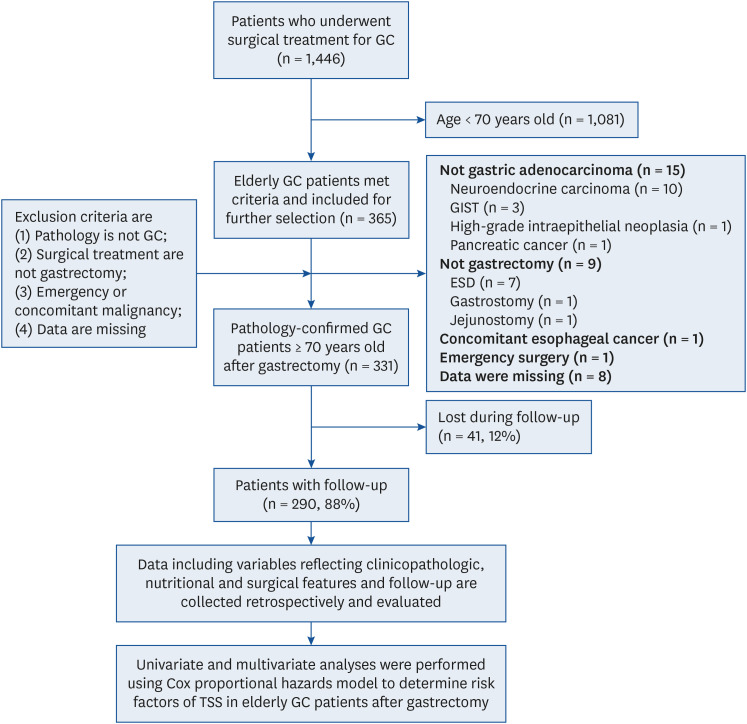
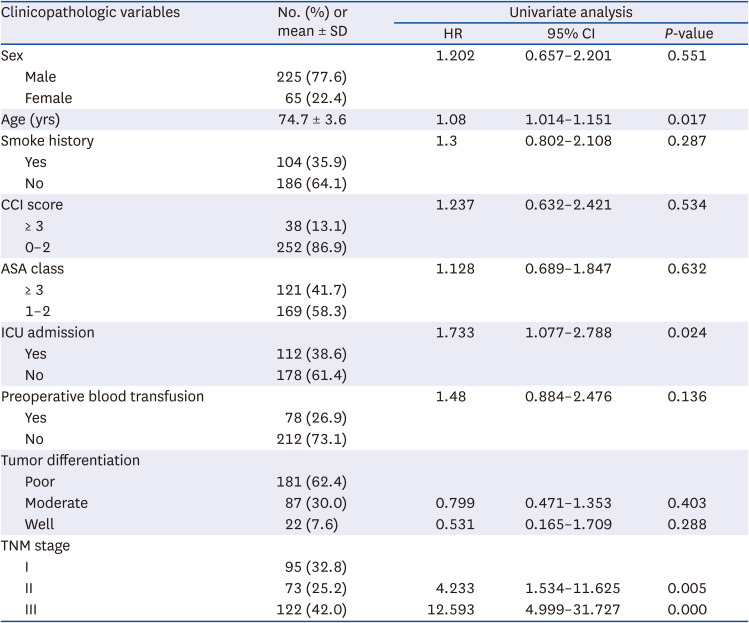
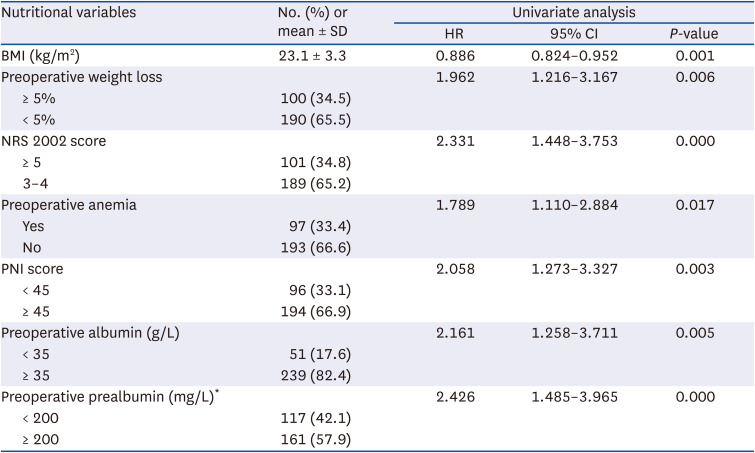
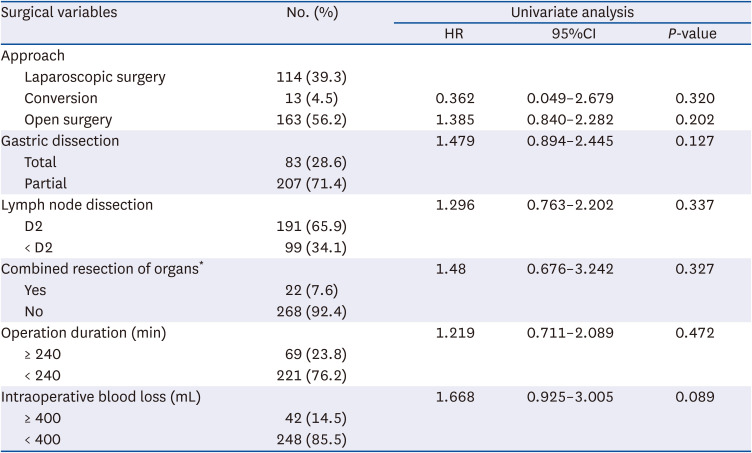
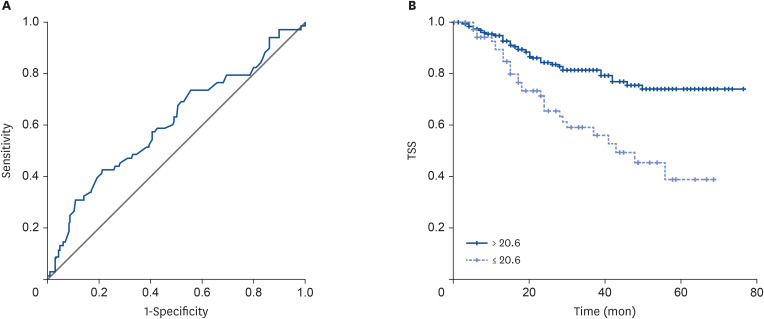
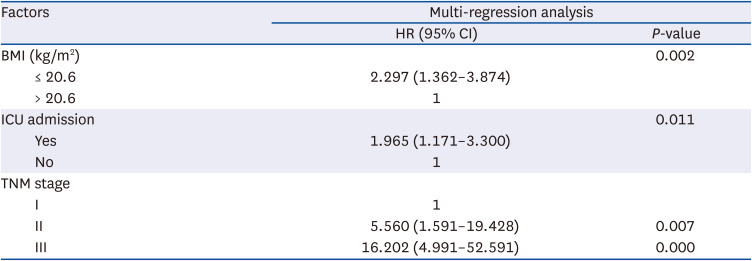




 PDF
PDF Citation
Citation Print
Print



 XML Download
XML Download